steering wheel CHEVROLET S10 1993 2.G Owners Manual
[x] Cancel search | Manufacturer: CHEVROLET, Model Year: 1993, Model line: S10, Model: CHEVROLET S10 1993 2.GPages: 356, PDF Size: 20.85 MB
Page 60 of 356
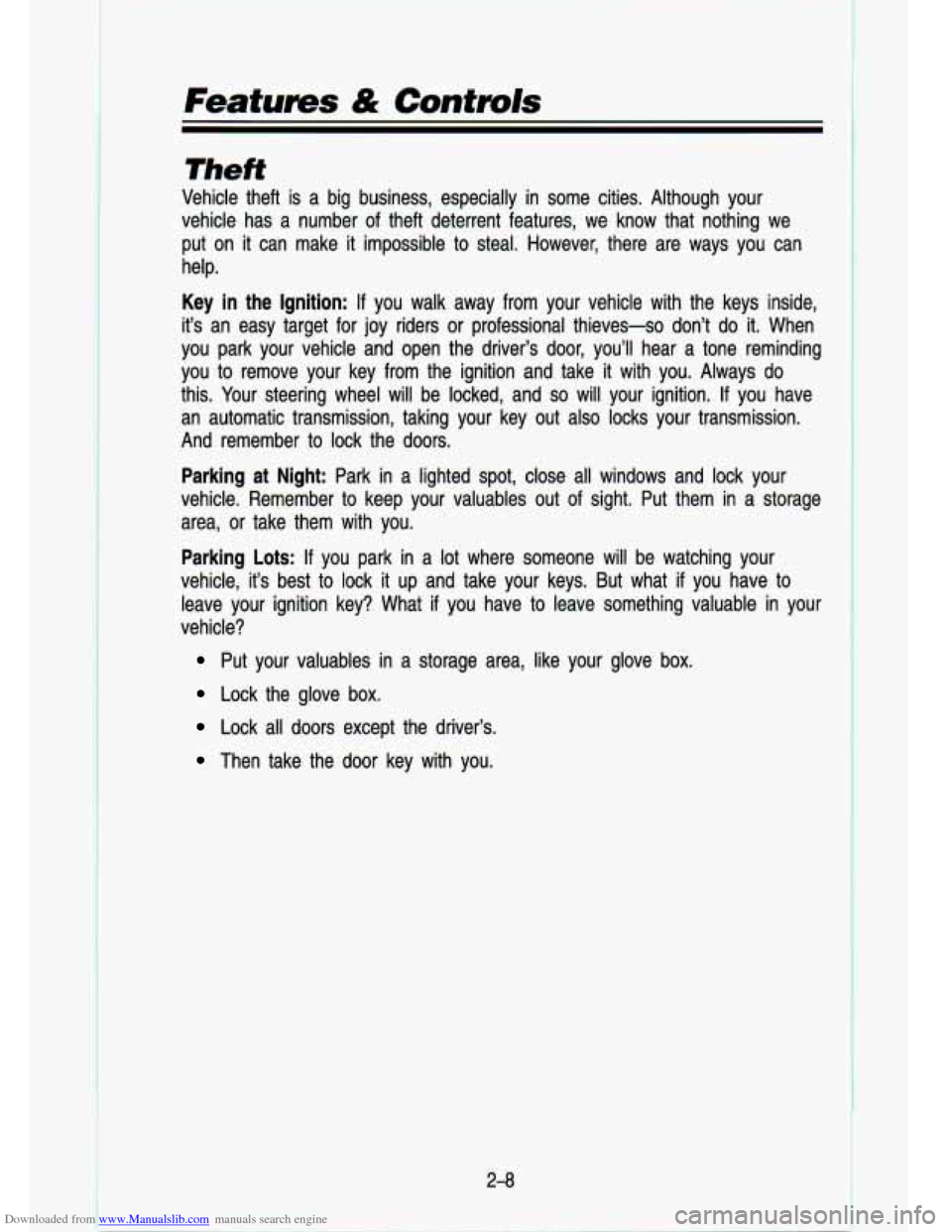
Downloaded from www.Manualslib.com manuals search engine Theft
Vehicle theft is a big business, especially in some cities. Although your
vehicle has a number of theft deterrent features, we know that nothing we
put on
it can make it impossible to steal. However, there are ways you can
help.
Key in the Ignition:
If you walk away from your vehicle with the keys inside,
it’s an easy target for joy riders or professional thieves-s\
o don’t
do it. when^
you park your vehicle and open the driver’s door, you’ll \
hear a tone reminding
you to remove your key from the ignition and take it with you. Always
do
this. Your steering wheel will be locked, and so will your ignition. If you have
an automatic transmission, taking your key out also locks your \
transmission.
And remember to lock the doors.
Parking at Night: Park in a lighted spot, close all windows and lock your
vehicle. Remember to keep your valuables out of sight. Put them in a storage
area, or take them with you.
Parking Lots:
If you park in a lot where someone will be watching your
vehicle, it’s best to lock it up and take your keys. But what
if you have to
leave your ignition key? What
if you have to leave somethina valuable in vour
vehicle?
Put your valuables in a storage area, like your glove DOX.
Lock the glove box.
Lock all doors except the driver’s.
Then take the door key with you.
2-8
1
Page 61 of 356
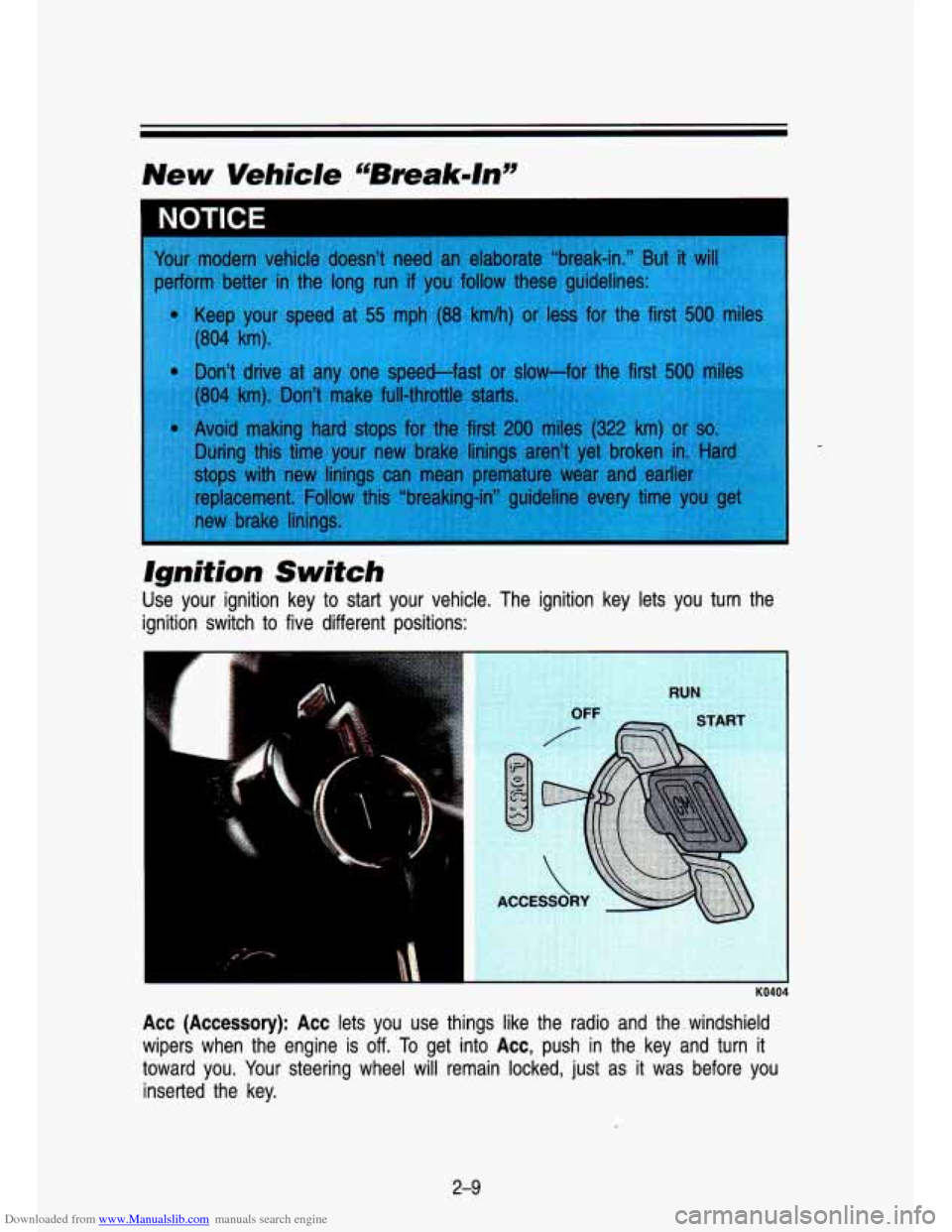
Downloaded from www.Manualslib.com manuals search engine New Vehicle c'Break-ln99
IYU I IW
ignition Switch
Use your ignition key to start your vehicle. The ignition key \
lets you turn the
ignition switch
to five different positions:
F
KO404
Acc (Accessory): Acc lets you use things like the radio and \
the windshield
wipers when the engine is
off. To get into Acc, push in the key and turn it
toward you. Your steering wheel will remain locked,
just as it was before you
inserted the key.
2-9
Page 62 of 356
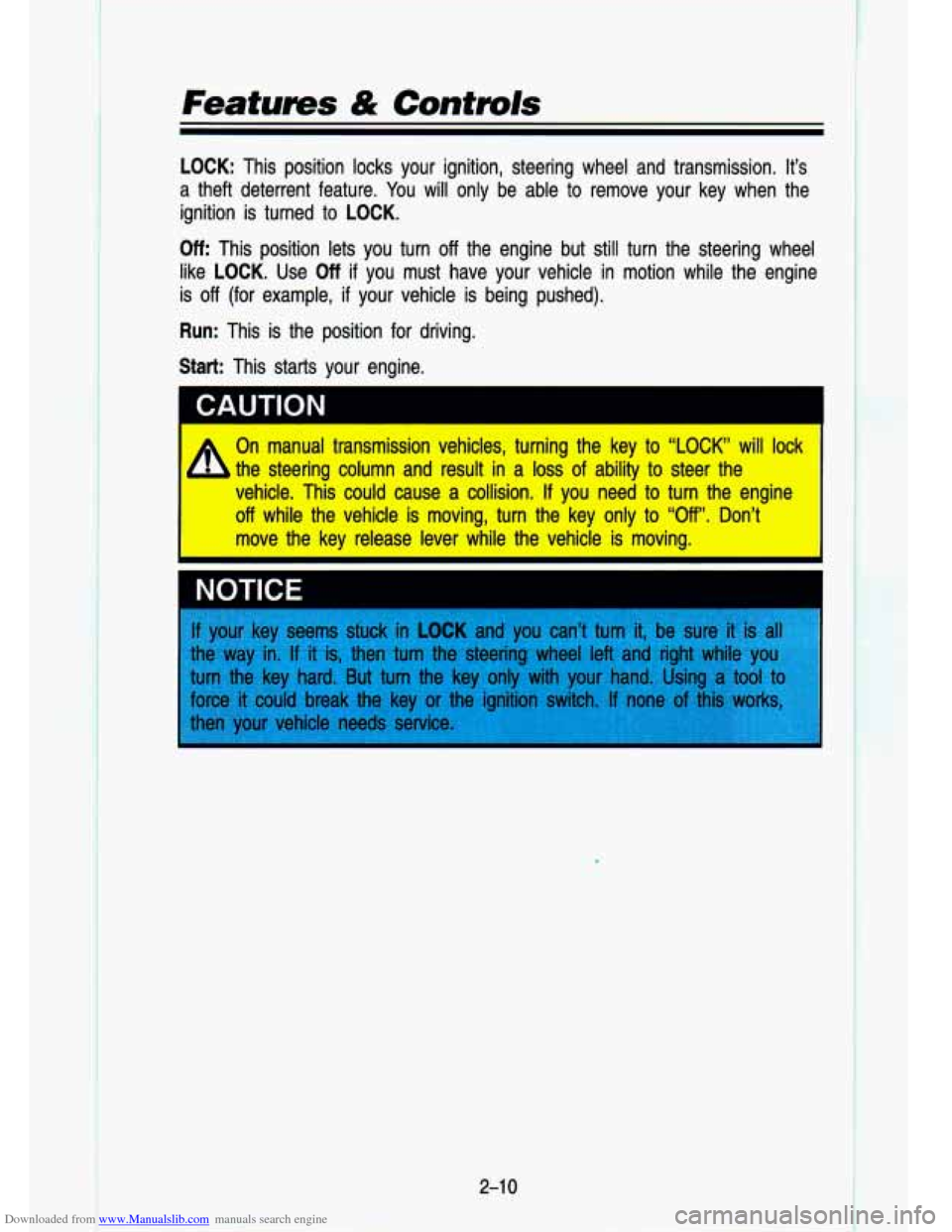
Downloaded from www.Manualslib.com manuals search engine .. ~ .
.. ..
Features & Contmls
LOCK: This position locks your ignition, steering wheel and tra\
nsmission. It’s
a theft deterrent feature. You will only be able to remove your key when the
ignition
is turned to LOCK.
Off: This position lets you turn off the engine but still turn the steering wheel
like LOCK. Use Off if you must have your vehicle in motion while the engine
is
off (for example, if your vehicle is being pushed).
Run: This is the position for driving.
Start: This starts your engine.
On manual transmission vehicles, turning the key to
“LOCK’ will lock
vehicle. This coiu18d cause am collision. If you need to turn the engiw
off Mhile the vehicle is moving, turn the key only to “OW. Don’t
mve the key release lever while the vehicle is moving.
- the steering column an’d result in a loss of ability to steer the
2-1 0
Page 85 of 356
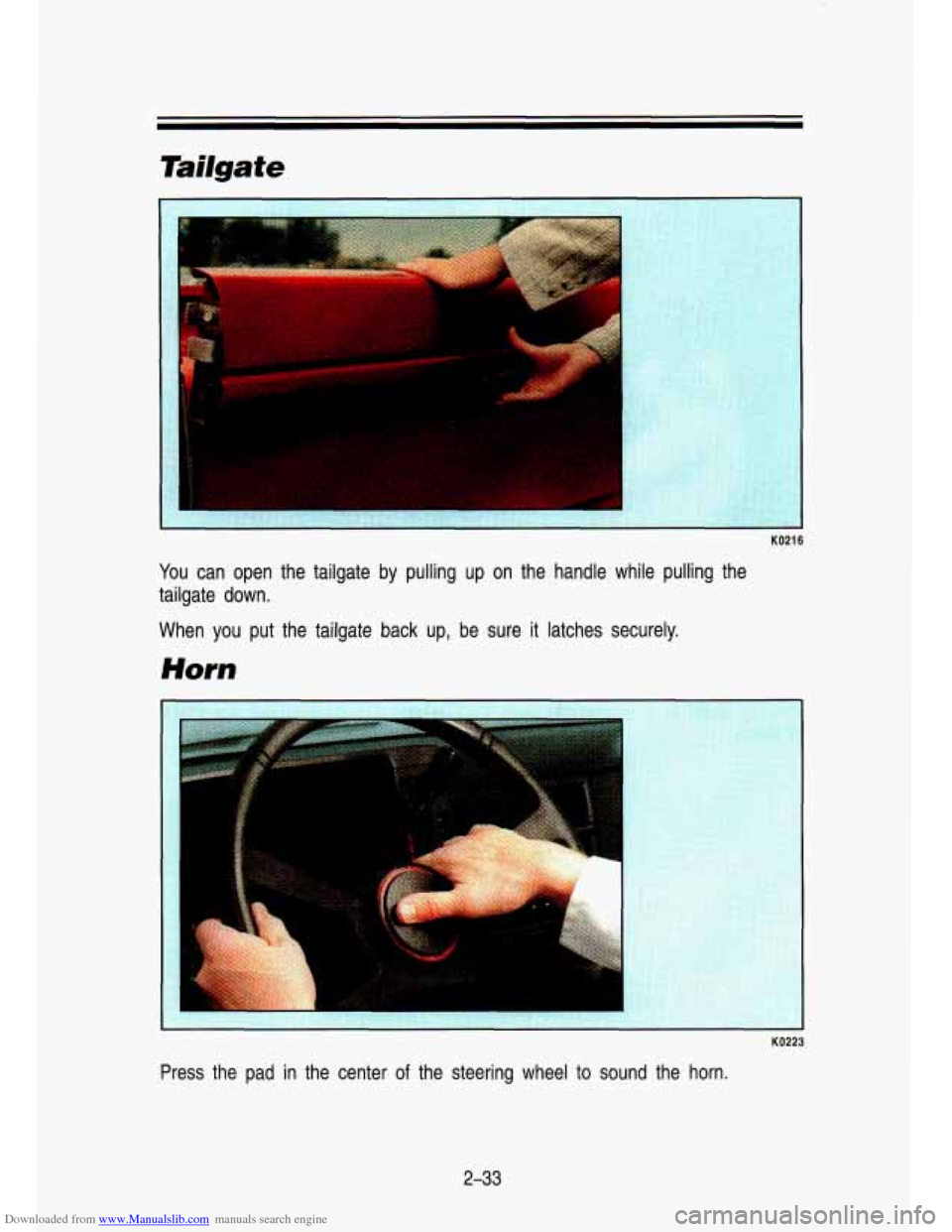
Downloaded from www.Manualslib.com manuals search engine Tailgate
KO216
You can open the tailgate by pulling up on the handle while pulling the
tailgate down.
When you put the tailgate back up, be sure it latches securely.
Horn
KO223
Press the pad in the center of the steering wheel to sound the horn.
2-33
Page 86 of 356
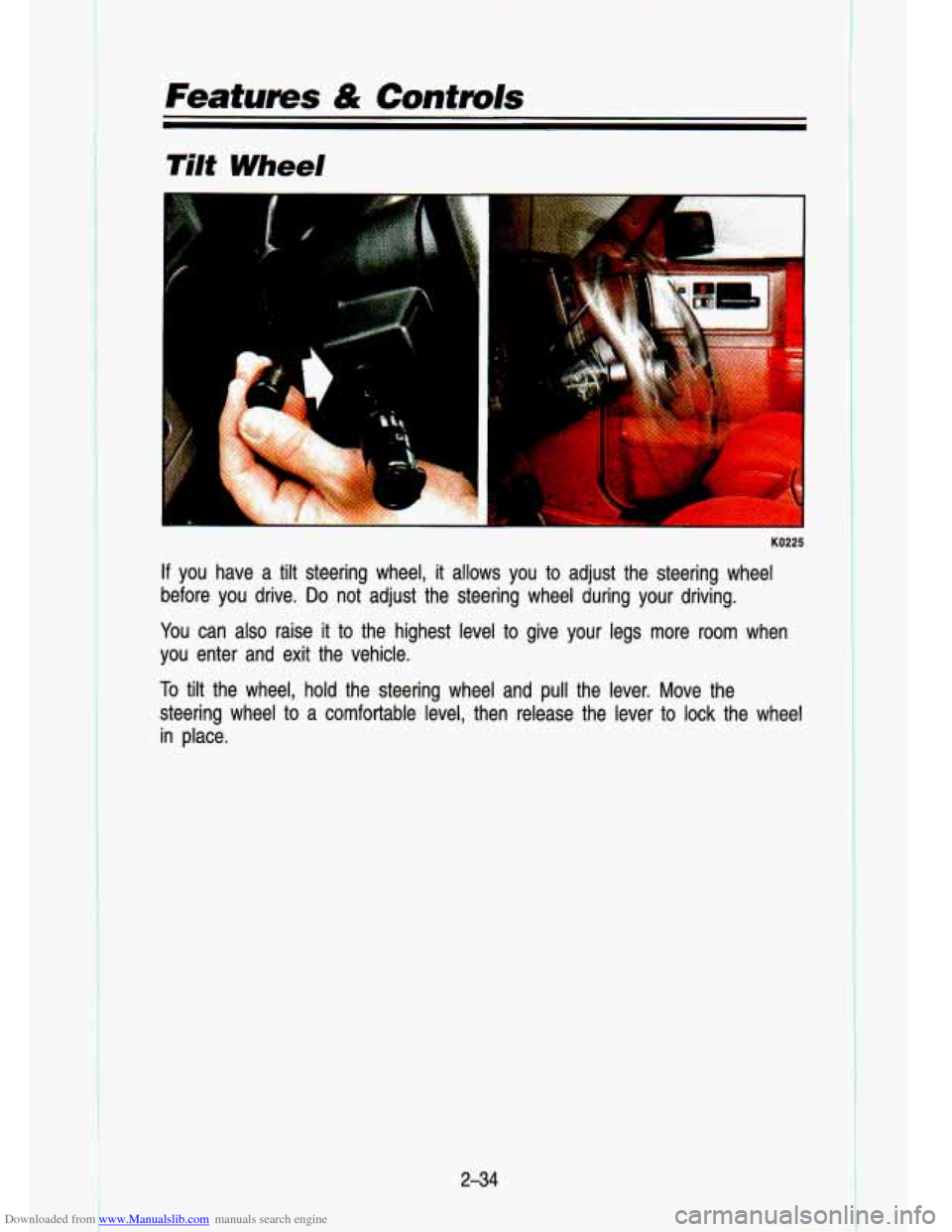
Downloaded from www.Manualslib.com manuals search engine Features & Controls
Tilt Wheel
+j ....
I
KO225
If you have a tilt steering wheel, it allows you to adjust the steering wheel
before you drive.
Do not adjust the steering wheel during your driving.
You can also raise it to the highest level to give your legs more ro\
om when
you enter and
exit the vehicle.
To tilt the wheel, hold the steering wheel and pull the lever. M\
ove the
steering wheel to a comfortable level, then release the lever to lock the wheel
in place.
234
1
Page 155 of 356
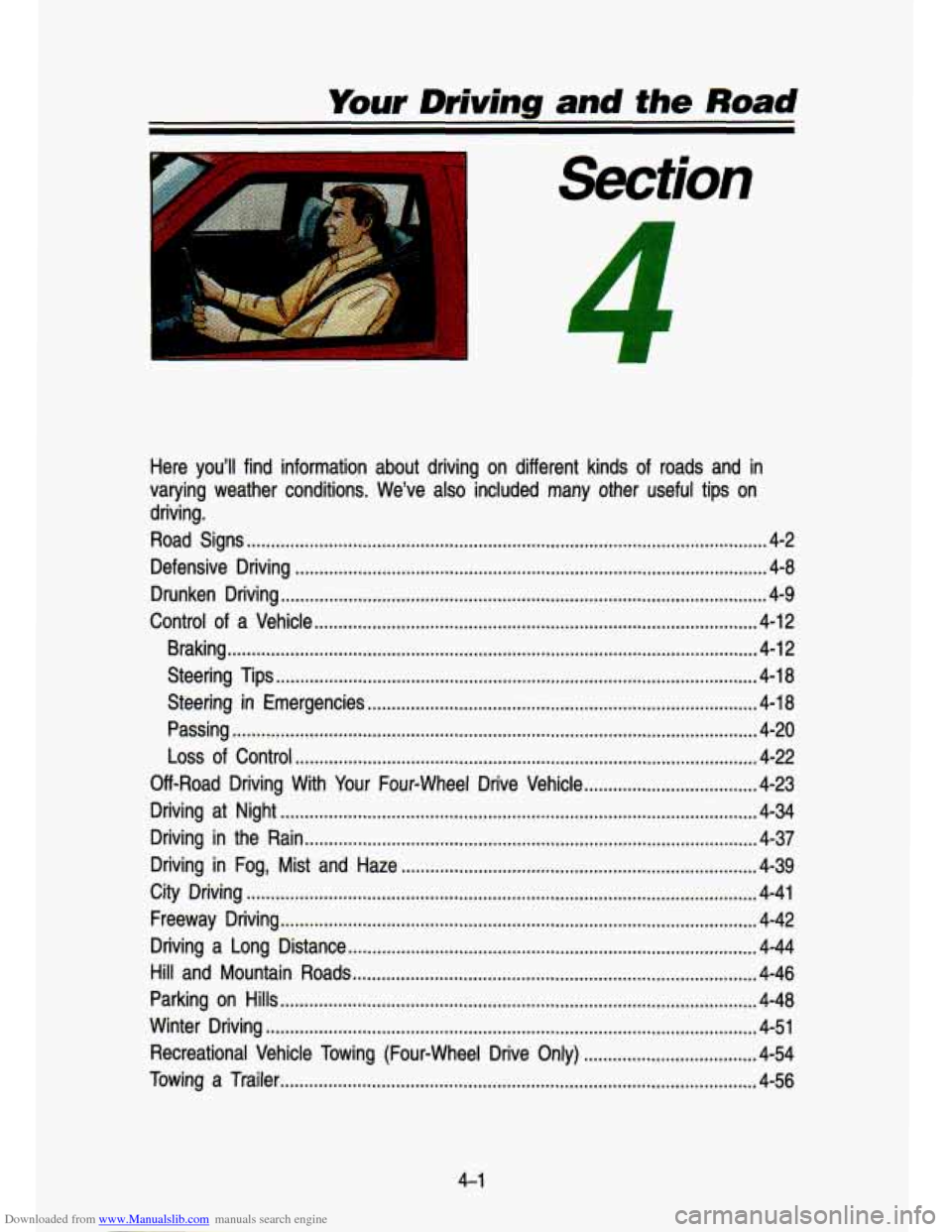
Downloaded from www.Manualslib.com manuals search engine Your Driving and the Road
.
Section
Here you’ll find information about driving on different kinds\
of roads and in
varying weather conditions
. We’ve also included many other useful tips on
driving
.
Road Signs ........................................................................\
.................................... 4-2
Defensive Driving
........................................................................\
.......................... 4-8
Drunken Driving
........................................................................\
............................. 4-9
Control
of a Vehicle ........................................................................\
.................... 4-12
Braking
........................................................................\
...................................... 4-12
Steering Tips
........................................................................\
............................ 4-18
Steering in Emergencies
........................................................................\
......... 4-18
Passing
........................................................................\
..................................... 4-20
Loss of Control ........................................................................\
........................ 4-22
Off-Road Driving With Your Four-wheel Drive Vehicle
.................................... 4-23
Driving at Night
........................................................................\
........................... 4-34
Driving in the Rain
........................................................................\
...................... 4-37
Driving in Fog, Mist and Haze
........................................................................\
.. 4-39
City Driving
........................................................................\
.................................. 4-41
Freeway Driving
........................................................................\
........................... 4-42
Driving a Long Distance
........................................................................\
............. 4-44
Hill and Mountain Roads
........................................................................\
............ 4-46
Winter Driving
........................................................................\
.............................. 4-51
Recreational Vehicle Towing (Four-wheel Drive Only)
.................................... 4-54
Towing a Trailer
........................................................................\
........................... 4-56
Parking
on Hills ........................................................................\
........................... 4-48
4-1
Page 171 of 356
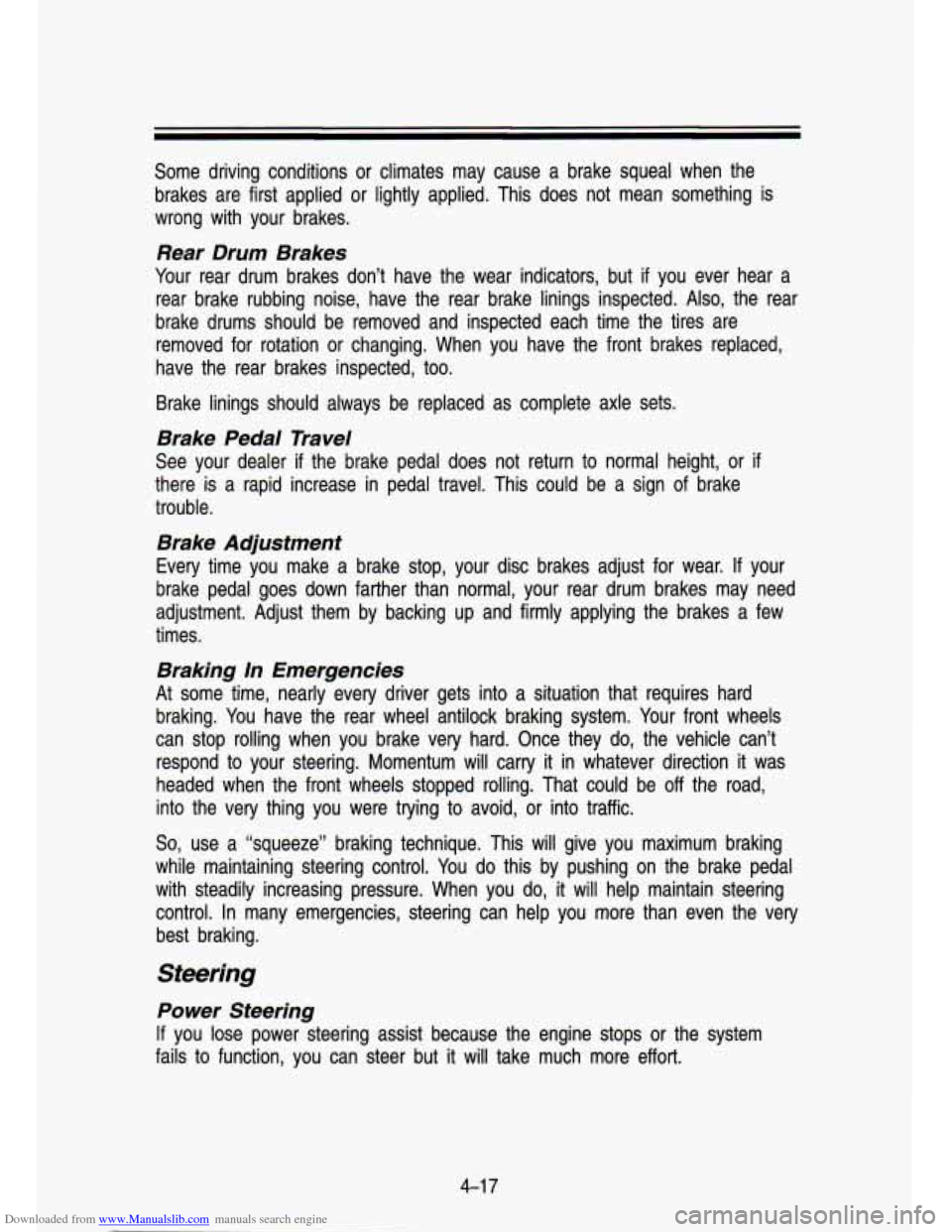
Downloaded from www.Manualslib.com manuals search engine Some driving conditions or climates may cause a brake squeal w\
hen the brakes are first applied or lightly applied. This does not mea\
n something is
wrong with your brakes.
Rear Drum Brakes
Your rear drum brakes don’t have the wear indicators, but i\
f you ever hear a
rear brake rubbing noise, have the rear brake linings inspected\
. Also, the rear
brake drums should be removed and inspected each time the tire\
s are
removed for rotation or changing. When you have the front brak\
es replaced,
have the rear brakes inspected, too.
Brake linings should always be replaced as complete axle sets. \
Brake Pedal Travel
See your dealer if the brake pedal does not return to normal height, or if
there is a rapid increase in pedal travel. This could be a s\
ign of brake
trouble.
Brake Adjustment
Every time you make a brake stop, your disc brakes adjust for\
wear. If your
brake pedal goes down farther than normal, your rear drum brak\
es may need
adjustment. Adjust them by backing up and firmly applying the \
brakes a few
times.
Braking In Emergencies
At some time, nearly every driver gets into a situation that requires hard
braking. You have the rear wheel antilock braking system. Your front wheels
can stop rolling when you brake very hard. Once they do, the \
vehicle can’t respond to your steering. Momentum will carry
it in whatever direction it was
headed when the front wheels stopped rolling. That could be of\
f the road,
into the very thing you were trying to avoid, or into traffic.
So, use a “squeeze” braking technique. This will give you max\
imum braking
while maintaining steering control. You do this by pushing on the brake pedal
with steadily increasing pressure. When you do, it will help maintain steering
control. In many emergencies, steering can help you more than \
even the very
best braking.
Steering
Power Steering
If you lose power steering assist because the engine stops or the\
system
fails to function, you can steer but
it will take much more effort.
4-1 7
Page 172 of 356
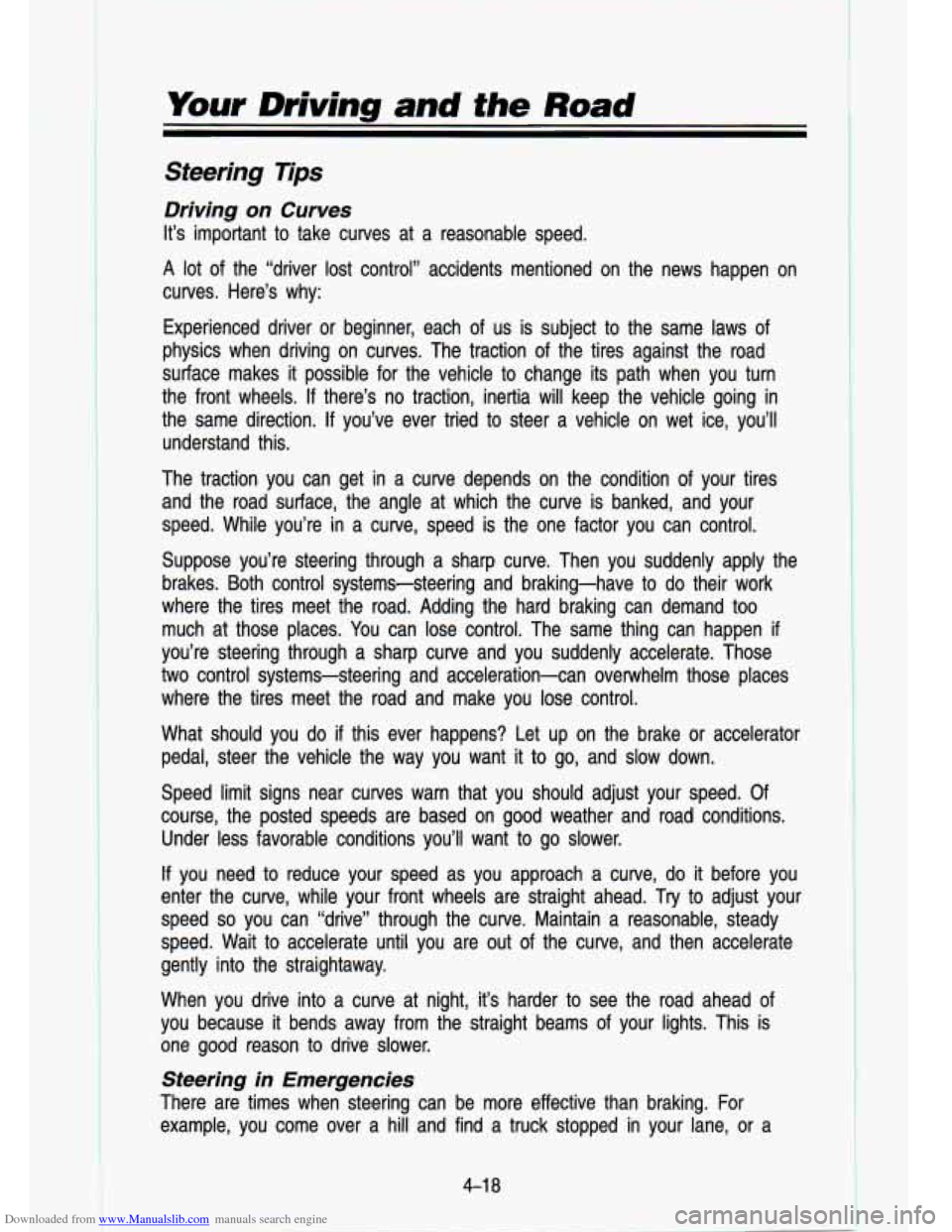
Downloaded from www.Manualslib.com manuals search engine Your Driving and the Road
Steering Tips
Driving on Curves
It’s important to take curves at a reasonable speed.
A lot of the “driver lost control” accidents mentioned on the news \
happen on
curves. Here’s why:
Experienced driver or beginner, each of us is subject to the same laws of
physics when driving on curves. The traction of the tires against the road
surface makes it possible for the vehicle to change its path when you turn
the front wheels.
If there’s no traction, inertia will keep the vehicle going in
the same direction.
If you’ve ever tried to steer a vehicle on wet ice, you’ll \
understand this.
The traction you can get in a curve depends on the condition of your tires
and the road surface, the angle at which the curve is banked, and your
speed. While you’re in a curve, speed is the one factor you can control.
Suppose you’re steering through a sharp curve. Then you sudd\
enly apply the
brakes. Both control systems-steering and braking-have to do their work
where the tires meet the road. Adding the hard braking can de\
mand too
much at those places. You can lose control. The same thing can happen
if
you’re steering through a sharp curve and you suddenly accel\
erate. Those
two control systems-steering and acceleration-can overwhelm those places
where the tires meet the road and make you lose control.
What should you
do if this ever happens? Let up on the brake or accelerator
pedal, steer the vehicle the way you want it to go, and slow down.
Speed limit signs near curves warn that you should adjust your\
speed. Of
course, the posted speeds are based on good weather and road \
conditions. Under less favorable conditions you’ll want to go slower.
If you need to reduce your speed as you approach a curve, do it before you
enter the curve, while your front wheels are straight ahead. Try to adjust your
speed
so you can “drive” through the curve. Maintain a reasonable, \
steady
speed. Wait to accelerate until you are out of the curve, and then accelerate
gently into the straightaway.
When you drive into a curve at night, it’s harder to see the road ahead of
you because it bends away from the straight beams of your lights. This is
one
good reason to drive slower.
Steering in Emergencies
There are times when steering can be more effective than braki\
ng. For
example, you come over a hill and find a truck stopped in your lane, or a
4-1 %
Page 173 of 356
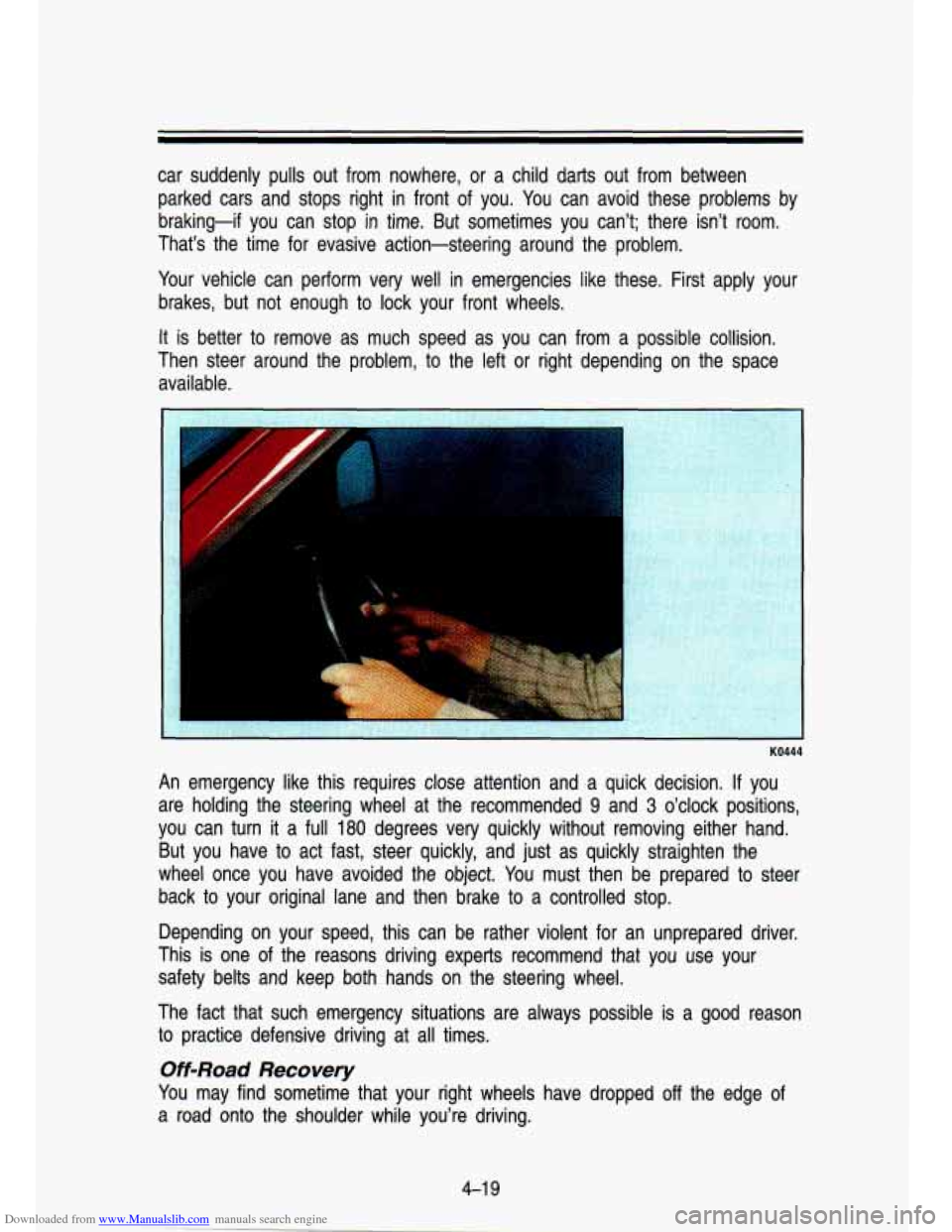
Downloaded from www.Manualslib.com manuals search engine car suddenly pulls out from nowhere, or a child darts out from between
parked cars and stops right in front of you. You can avoid these problems by
braking-if you can stop in time. But sometimes you can’t; there isn’t room.
That’s the time for evasive action-steering around the proble\
m.
Your vehicle can perform very well in emergencies like these. First apply your
brakes, but not enough to lock your front wheels.
It is better to remove as much speed as you can from a possible collision.
Then steer around the problem, to the left or right depending on the space
available.
KO444
An emergency like this requires close attention and a quick de\
cision. If you
are holding the steering wheel at the recommended
9 and 3 o’clock positions,
you can turn
it a full 180 degrees very quickly without removing either hand.
But you have to act fast, steer quickly, and just as quickly straighten the
wheel once you have avoided the object. You must then be prepared to steer
back to your original lane and then brake
to a controlled stop.
Depending on your speed, this can be rather violent for an un\
prepared driver.
This is one
of the reasons driving experts recommend that you use your
safety belts and keep both hands on the steering wheel.
The fact that such emergency situations are always possible
is a good reason
to practice defensive driving at
all times.
Off-Road Recovery
You may find sometime that your right wheels have dropped off the edge of
a road onto the shoulder while you’re driving.
Page 174 of 356
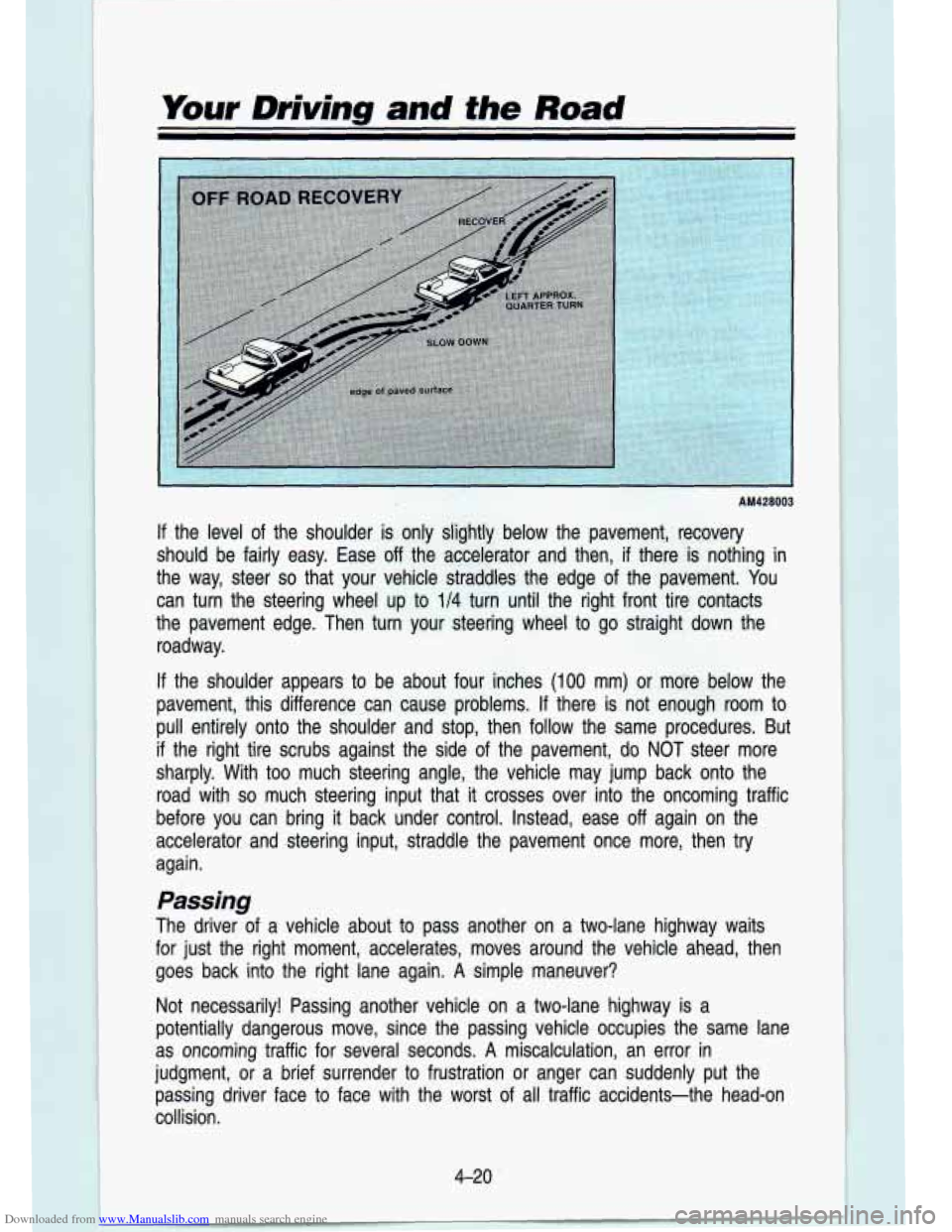
Downloaded from www.Manualslib.com manuals search engine Your Driving and the Road
AM428003
If the level of the shoulder is only slightly below the pavement, recovery
should be fairly easy. Ease off the accelerator and then,
if there is nothing in
the way, steer
so that your vehicle straddles the edge of the pavement. You
can turn the steering wheel up to
114 turn until the right front tire contacts
the pavement edge. Then turn your steering wheel to go straigh\
t down the
roadway.
If the shoulder appears to be about four inches (100 mm) or more below the
pavement, this difference can cause problems.
If there is not enough room to
pull entirely onto the shoulder and stop, then follow the same\
procedures. But
if the right tire scrubs against the side of the pavement, do NO\
T steer more
sharply. With too much steering angle, the vehicle may jump ba\
ck onto the
road with
so much steering input that it crosses over into the oncoming traffic
before you can bring it back under control. Instead, ease
off again on the
accelerator and steering input, straddle the pavement once more,\
then
try
again.
Passing
The driver of a vehicle about to pass another on a two-lane highway waits
for just the right moment, accelerates, moves around the vehicl\
e ahead, then goes back into the right lane again.
A simple maneuver?
Not necessarily! Passing another vehicle on a two-lane highway is a\
potentially dangerous move, since the passing vehicle occupies t\
he same lane
as oncoming traffic for several seconds.
A miscalculation, an error in
judgment, or a brief surrender to frustration or anger can sud\
denly put the passing driver face to face with the worst of all traffic accidents-the head-on
collision.
4-20